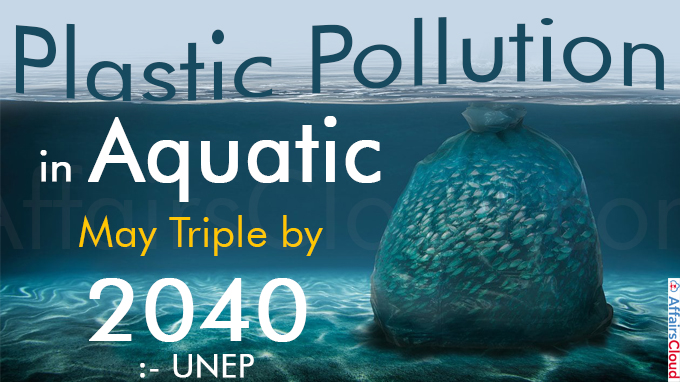 The new comprehensive assessment report titled “From Pollution to Solution: a global assessment of marine litter and plastic pollution” released by the United Nations(UN) Environment Programme (UNEP) has stated that without proper efforts to reduce ocean plastic pollution, the amount of plastic waste entering the aquatic ecosystem is estimated to triple from 9-14 million ton per year in 2016 to 23-37 million ton per year by 2040.
The new comprehensive assessment report titled “From Pollution to Solution: a global assessment of marine litter and plastic pollution” released by the United Nations(UN) Environment Programme (UNEP) has stated that without proper efforts to reduce ocean plastic pollution, the amount of plastic waste entering the aquatic ecosystem is estimated to triple from 9-14 million ton per year in 2016 to 23-37 million ton per year by 2040.
With another approach, plastic pollution is estimated to double from 19-23 million tons in 2016 to around 53 million tons by 2030.
- At present, the amount of plastics in the oceans is estimated to be around 75-199 million tons.
Note: This report will inform the discussion at the 5th session of the UN Environment Assembly(UNEA 5.2) in 2022.
Key points:
i.It is estimated that the annual loss in the value of plastic packaging waste during sorting and processing is around 80-120 billion USD.
ii.The plastic alters the carbon cycling through their effect on primary production in marine, freshwater and terrestrial systems. Marine ecosystems like mangroves, seagrasses, corals and salt marshes play a major role in sequestering carbon.
iii.The greenhouse gas emission from plastics is projected to increase from in 2015 were 1.7 gigatonnes of carbon dioxide equivalent (GtCO2e) to around 6.5 GtCO2e by 2050 or 15 per cent of the global carbon budget.
iv.The mismanagement of African and Asian watersheds results in the release of millions of tons of waste plastic into the major terrestrial and aquatic ecosystems and eventually into the oceans.
Some of the key findings of the report:
Threat to marine life: Plastics, the most harmful and persistent fraction of marine litter, accounts to around 85% of total marine waste.
- This waste causes lethal and sublethal effects like entanglement, starvation, drowning, laceration of internal tissues, smothering and deprivation of oxygen and light, physiological stress, and toxicological harm to the whales, seals, turtles, birds and fish as well as to the invertebrates like bivalves, plankton, worms and corals.
Threat to human life: Human uptake of microplastics through seafood poses a major threat to coastal and indigenous communities.
- Ingestion of seafood contaminated with plastics, exposure to pathogenic bacteria transported on plastics, and leaching out of substances of concern to coastal waters are some of the major risks to human health.
Source of marine plastics:
The main source of marine plastic pollution is land-based, around 7000 million metric tons of plastic out of the 9000 million metric tons of plastic produced between 1950 and 2017 has become plastic waste.
- Around 14% of this has been incinerated, 76% were discarded in landfills and 2900 million metric tons (which includes the 8% that were recycled) are still in use.
Click here for the full report
Recent Related News:
On September 14, 2021, three United Nations (UN) agencies viz. the Food and Agriculture Organization (FAO), UN Development Programme (UNDP) and UN Environment Programme (UNEP) released a report titled ‘A multi-billion-dollar opportunity: Repurposing agricultural support to transform food systems’.
About United Nations Environment Programme (UNEP):
Executive Director– Inger Andersen
Headquarters– Nairobi, Kenya
Incepted in 1972




